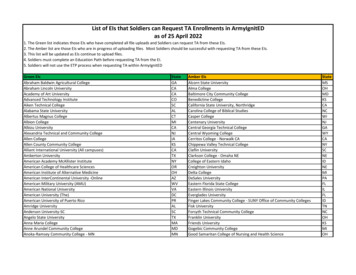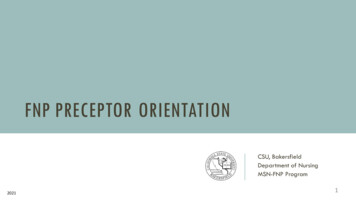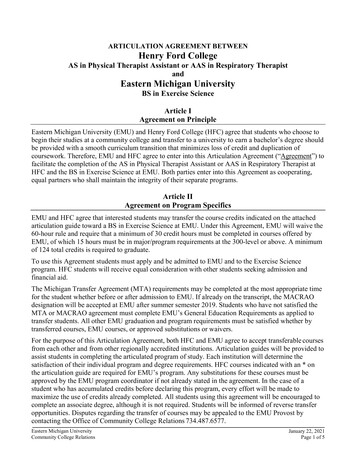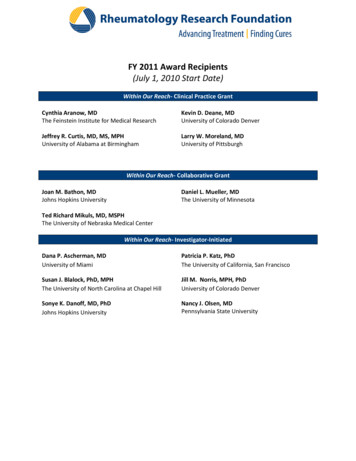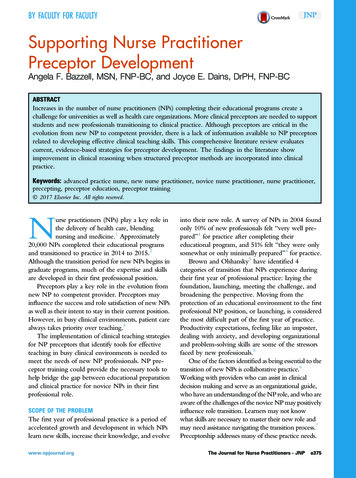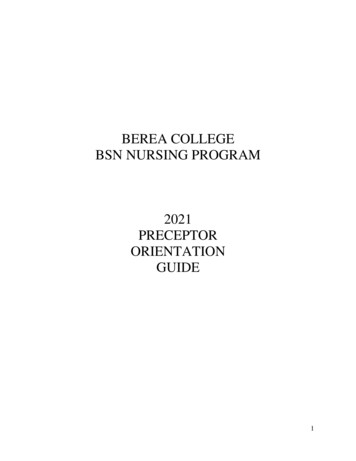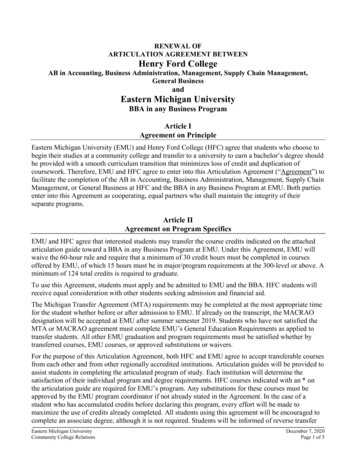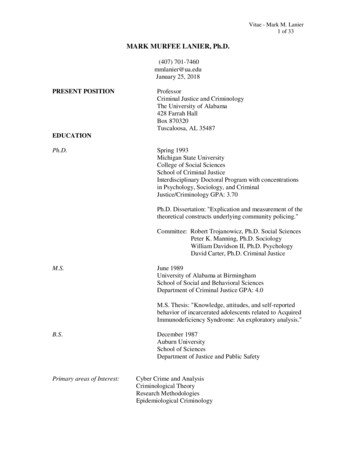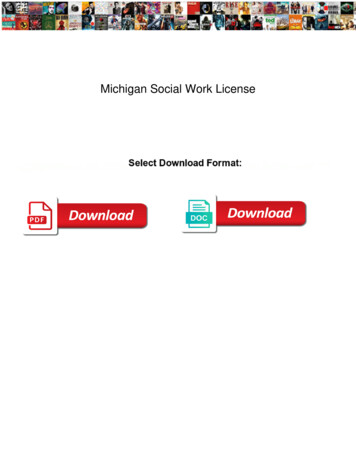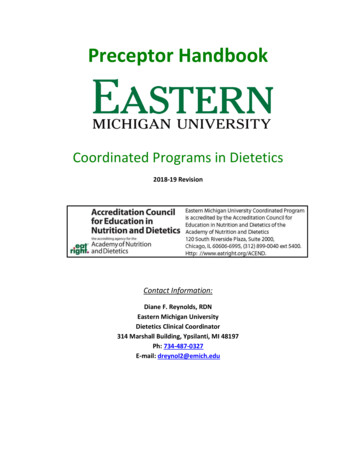
Transcription
Preceptor HandbookCoordinated Programs in Dietetics2018-19 RevisionContact Information:Diane F. Reynolds, RDNEastern Michigan UniversityDietetics Clinical Coordinator314 Marshall Building, Ypsilanti, MI 48197Ph: 734-487-0327E-mail: dreynol2@emich.edu
Table of ContentsPageBenefits of Precepting3Thank You and Acknowledgements5The Eastern Michigan University Coordinated Programs in DieteticsProgram Mission Statement6What is a Coordinated Program? How is it different from an Internship?7Coordinated Program Curriculum – Programs of Study for BS and MS8Student’s Role in Supervised PracticeHow Does EMU Prepare the Student?11Responsibilities and Expectations of EMU Students12Supervised Practice from a Student’s Perspective13Preceptor’s Role in Supervised PracticeResponsibilities of the Preceptor14Characteristics of Effective Preceptors17Helpful Hints for Preceptors18Completion of an Affiliation Agreement - Certificate of Insurance19Resources and Support20Handling Difficult or Problem Situations21Preceptor Self-Evaluation Form23Appendix APolicy on Professionalism26(from EMU Coordinated Program - Student Handbook)Eastern Michigan University Coordinated Programs in Dietetics 2
Benefits of PreceptingCPEU Credits for Precepting: cdrnet.org1. From the Commission on Dietetic Registration (CDR), precepting will be includedunder the current Professional Leadership and Precepting Activity Type 190.There is a three (3) CPEU/ year, fifteen (15) CPEU/5 year recertification periodlimit for Leadership and/or Precepting activities. Go to: https://www.cdrnet.orgPreceptors can send the Self-Reflection Form & Confirmation Statement to EMUDietetics Clinical Coordinator for signature, following service as a preceptor forour program.2. CDR also offers a free of charge Online Dietetics Preceptor Training Course,approved for 8 CPEU’s for RDN’s. This program is an excellent next step towarddeveloping yourself as a preceptor. We recommend you access this valuableself-paced tool. To enter the course, go to: http://www.cdrcampus.com/ Themodules are now separated into 2 or 3 credit sections.3. EMU Coordinated Programs in Dietetics will also offer a CPEU credit webinarseries available for free-of-charge, only to our preceptors. These are prerecorded webinars you will be able to view at your convenience following serviceas a preceptor for our program.Help with workload: Students need to develop proficiency at gathering assessmentdata and doing the very things that can be most time consuming for you. Once they areproperly trained and oriented to your facility, they can be very helpful. This is mostapplicable in their final (second) year of our program.A fresh perspective and up-to-date information: Students have very little priorhistory influencing their decisions and can often bring fresh creativity to the workplace.Nutrition knowledge is constantly evolving and growing with continuous research.Students have access to the most current information in the field. Allowing them toshare their knowledge makes the student feel valued and builds confidence.Eastern Michigan University Coordinated Programs in Dietetics 3
Further develop your management skills: Precepting requires a variety ofmanagement skills, from time and project management to coaching and personneldevelopment. If management is a personal career goal, this can be a very valuablelearning experience for you.Opportunity to get a special project done: Use student case studies, course material,assignments and projects to do an analysis or project that you’ve identified as importantfor your job position or facility, yet haven’t had the time or resources to complete.Sometimes your project can fit nicely with a student Practice Experience competencyrequirement. This allows for the work to be a win-win situation for you and the student.Graduate Education: EMU also has an online Master of Science in Human Nutritiongraduate program. This is a great way to further your education and gain anothercredential in our ever-developing field of nutrition. We’d be happy to answer any of yourquestions and offer you support to apply for the EMU Master of Science in HumanNutrition program. You can access the Student Handbook for more information utrition-handbook-2018-2019.pdfEastern Michigan University Coordinated Programs in Dietetics 4
Thank You and AcknowledgementsThe faculty and staff of the Eastern Michigan University (EMU) CoordinatedPrograms in Dietetics (CP) would like to extend a heartfelt thank you for the significantcontribution you make to our program, the education of future dietitians, and to theprofession of dietetics. Our program would not exist if it were not for you. We fullyrecognize that most of the rewards are intangible and performing the role of preceptortakes valuable time away from demanding schedules.We encourage you to share your thoughts and provide feedback about ourprogram. Please contact us at any point to discuss your ideas.It is with enormous respect that we acknowledge you as colleagues and friends,as well as partners in preparing the dietitians of the future to enter the field we are allpassionate about. We created this handbook to serve as a resource for our preceptors.We hope you will find it to be a helpful tool.Thank you!Eastern Michigan UniversityFaculty & Staff of theCoordinated Programs in DieteticsThank you to the reviewers for the 2018-19 Handbook revision:Diane F. Reynolds, RDN - Clinical CoordinatorNicholas Pomante, MS, RD, Part-Time LecturerAlice Jo Rainville, PhD, RD, CHE, SNS, FAND, Professor and Coordinator of M.S. inHuman Nutrition programKyunghee Choi, MS, RD, Full-Time LecturerEastern Michigan University Coordinated Programs in Dietetics 5
Mission of the Coordinated ProgramThe Coordinated Programs in Dietetics at Eastern Michigan Universityeducate and graduate students prepared for entry-level practice asregistered dietitians, with a concentration in entrepreneurship.The CP achieves the mission through: Providing an exceptional learning environment so students are continuouslyinterpreting and responding to food and nutrition service delivery in a changingsocial and economic environment while applying new technologies to theirdietetic education Providing student-centered learning opportunities, allowing students to pursuetheir specific interests Encouraging and engaging in collaboration and partnerships with the community Promoting evidence-based knowledge and skills for students and graduates Enhancing students’ critical thinking and reflection skills by collaborating withfaculty to develop and complete research-based projectsEastern Michigan University Coordinated Programs in Dietetics 6
What is a Coordinated Program? How is it different from an Internship?Eastern Michigan University’s Coordinated Programs in Dietetics (CP) have beengraduating entry-level practitioners since 1974 and is one of only three accreditedCoordinated Programs in the state of Michigan.A Coordinated Program in Dietetics (CP) integrates didactic (classroom) instructionconcurrently with 1,200 hours of Supervised Practice Experience. This is accomplishedin 2 years; 2 fall semesters, 2 winter semesters and 1 or 2 summer semesters. Uponcompletion of our CP, students receive a bachelor’s or master’s degree (depending ontheir program of study) and are eligible to sit for the registration exam and beginpractice as a Registered Dietitian Nutritionist. We are not an ISPP (IndividualizedSupervised Practice Pathway) and are not a Dietetic Internship.A Dietetic Internship occurs after all didactic coursework is completed and a degree hasbeen awarded. Unlike an internship, students in a CP complete Supervised PracticeExperiences while completing their coursework. Because of this, there may be timeswhen a student will encounter a specific challenge that has not yet beentaught/reviewed in the course. It is these circumstances that will require understandingand expertise on the part of the preceptor. It is perfectly acceptable to expect thestudent to refer to the Nutrition Care Manual and other professional food and nutritionresources to fill temporary “gaps” in knowledge. These can be valuable learningexperiences.In a Coordinated Program (CP) didactic coursework and the 1200 “internship” hoursare completed concurrently. These hours are referred to as Supervised PracticeExperience (SPE). The competencies required in SPE are the same as in a traditionalinternship.Eastern Michigan University Coordinated Programs in Dietetics 7
BS and 2ndEastern Michigan University Coordinated Program InDieteticsBSIt is the student's responsibility to make sure that all general education and prerequisitecourses, as determined by EMU and the Coordinated Program in Dietetics, areappropriately completed.Professional Phaseof Study 58 CreditsStudents will complete the following courses as listed once they have applied and areaccepted into the Coordinated Program in DieteticsFALL 1 - Total Credits 15DTC330Nutrition TherapyI3DTCNutrition Therapy2331I ExperienceDTCFood Systems I3350DTCFood Systems I4351Experience*DTCNutrition of the3372Lifecycle*Summer before program start or 1st fallDTC 459DTC 375DTC422WINTER 1 - Total Credits 13NutrientDTC 302MetabolismMacronutrients*DTC 358DTC 370DTC 371Nutrition TherapyIINutrition TherapyII Experience334*Allowed to take out of sequenceSUMMER - Total Credits 6Development of theEntrepreneurial Dietitian15 weeksIntegrative Medicine 7.5 weeksFALL 2 - Total Credits 12NutrientMetabolism3MicronutrientsFood and Culture333WINTER 2 - Total Credits 12DTC 450DTC430CommunityNutrition3DTC 451DTCCommunity4DTC 470Food SystemsManagement IIFood SystemsMgmt IIExperienceNutrition Therapy242Eastern Michigan University Coordinated Programs in Dietetics 8
431DTC435NutritionExperienceSeminar inDieteticsProfessional Phaseof Study 73-76CreditsIII2Nutrition TherapyIII ExperienceDTC 471Eastern Michigan University CoordinatedProgram in Dietetics4Master ofScienceIt is the student’s' responsibility to make sure all prerequisite courses are completed as determined by the Coordinated Program inDietetics. Students will complete the following courses as listed once they have applied and are accepted into the CoordinatedProgram in DieteticsFALL 1 - Total Credits 15DTC330Nutrition TherapyI3DTC531Nutrition TherapyI Experience2WINTER 1 - Total Credits taryDTCand Alternative3375MedicineDTCNutrition Therapy3370IIDTCNutrition Therapy4571II Experience*DTCResearch Design3500and MethodsDTCFood Systems I3350DTCFood Systems I4551Experience*DTCNutrition of the3372Lifecycle*Summer before program start or 1stfallSUMMER (10-15 weeks) - Total Credits 6-8DTCDevelopment of the3659Entrepreneurial DietitianMathStatistics for Graduate3502StudentsDTCThesis I or Non-Thesis691 orResearch I (not needed if2694taking DTC 601)FALL 2 - Total Credits 15NutrientDTCMetabolism3422Micronutrients*Choose Thesis,Non-ThesisResearch orResearch WritingoptionWINTER 2 - Total Credits 12DTC450Food SystemsManagement II2Eastern Michigan University Coordinated Programs in Dietetics 9
DTC430DTC631DTC435DTC692,693 eSeminar inDieteticsThesis II, NonThesis II orResearch Writing3DTC651Food SystemsMgmt IIExperience44DTC470Nutrition TherapyIII22DTC671Nutrition TherapyIII Experience43DTC 358 Food and Culture - take anytimeSUMMER (7.5-15 weeks) - Total Credits 6-7DTCThesis III or Non-Thesis693 or1Research III696DTCAdvanced Topics in Foods3608DTCAdvanced Topics in3618NutritionEastern Michigan University Coordinated Programs in Dietetics 10
Student’s Role in Supervised PracticeHow does EMU prepare the student?Coordinated Programs in Dietetics (CP) Program Prerequisite CoursesAcceptance to the program is by a second admissions (competitive) process. Studentscomplete the following coursework prior to entering the program; Survey of Organic Chemistry Foundations of Biochemistry Introductory Microbiology General Psychology Introductory Statistics Course Physiology DTC 108 Careers in Nutrition and Dietetics DTC 202 Principles of Nutrition DTC 251 Experimental Foods DTC 230 Fundamentals of Nutrition Therapy Medical TerminologyOnce accepted into the Program, students complete the following Program OrientationRequirements and a Medical Physical Exam, prior to starting the CP in the FallSemester; HIPAA training Adult/Child CPR, AED, First Aid Certification (American Heart AssociationHeartsaver Program or Red Cross Professional Rescuer Program or equivalent) Bloodborne Pathogens training Complete vaccinations and double TB skin test, per CDC recommendations Certified Background Check and 10-panel Drug Screen Students are required to be members of the Academy of Nutrition and Dieteticsand join a local/district dietetics association Must carry personal health insuranceEastern Michigan University Coordinated Programs in Dietetics 11
Student’s Role in Supervised PracticeResponsibilities and Expectations of EMU Students: Make initial contact with preceptor to determine time, date, location and dresscode for first day. Arrive at site on time each day, rested and prepared to learn. Comply with all policies and procedures in the EMU CP Student Handbook.Student receives and signs Handbook Statement of Understanding, indicatingthey understand and agree to abide by all content. Comply with all policies and procedures of SPE. Communicate questions, concerns, learning goals and needs. Have a positive attitude and be enthusiastic about their practice experience. Be flexible to accommodate requirements of the SPE and learning opportunities. Plan and organize assignments for each day and week. Take responsibility foraccomplishing the learning objectives for the SPE. Be intrinsically motivated. When assigned tasks are complete, seek more. Refrain from making personal calls, texts or checking emails while at SPE. Be willing to take risks and stretch outside of their personal comfort zone in orderto grow and learn. Conduct their own self-assessment of strengths and weaknesses. Seekopportunities to develop weak areas. Be respectful, patient and appreciative towards preceptors. Be receptive toward both positive and constructive feedback, as both have valuein developing professional skills.Eastern Michigan University Coordinated Programs in Dietetics 12
Student’s Role in Supervised PracticeSupervised Practice from a Student’s Perspective:I am not an intern. As a student in SPE in a CP, I can be anywhere in my professionalphase of education, from an entry level first year student to my final semester of thesecond year, but at no time am I done with my didactic classes , as an intern would be.Thus, I may have gaps in my knowledge and hope you will be understanding andhelpful. I am here to learn. Feel free to provide supplemental learning material tofacilitate my ability to function in your setting.I am not like your last student. Students come from a wide range of backgrounds. Someare young, inexperienced and have rarely worked before. Others are pursuing secondcareers, more mature and have a great deal of work experience. I might be comfortablewith patients or may need exposure to develop confidence with them. I come from arange of cultural and experience backgrounds that may enrich your workplace.No matter who I am, this is all new to me. Please be patient and encourage me to takerisks in order to develop confidence. For the most part, every experience that I enter is aforeign environment. It is similar to starting a new job every couple of months! Pleasetake the time to orient me to the physical environment and policies, and to evendescribe the culture at your particular facility.Please share with me your “tips and tricks”. Please let me learn from your experiencesby sharing the “tricks of the trade” and techniques you have developed along the way.How do you manage time and workload? How do you handle difficult situations? If aparticularly good learning opportunity arises, please include me in it.Please remember that I am still in school. I am in SPE and have a full load ofcoursework to attend to during evenings and weekends. I am expected to be flexibleand give you my full attention for the hours I have committed to. Many additional hoursbeyond SPE requirements may be impractical.Eastern Michigan University Coordinated Programs in Dietetics 13
Preceptor’s Role in Supervised PracticeResponsibilities of the Preceptor:COMMUNICATE: It is critical to communicate not only with the student, but also with theEMU Course Instructor and others in your organization regarding the student and theirlearning experience. Communicate regularly with your primary contact at EMU – the CourseInstructor. Make sure others in your organization know the student is going to be there andwhat should and should not be expected of them. Communicate on a planned and routine basis with the student regarding thespecific competencies they must achieve.ORIENT: Providing an orientation to the student saves you time and protects thestudent, the organization and your clients. If information is available electronically and/orin writing, they can refer back to it. Provide a tour and maps of the facility. Some sites have specific areas forstudents to park their cars. Many sites have HIPAA and emergency action plantraining. (EMU also provides HIPAA training annually for our students.) Many organizations have an orientation that covers the mission and goals of theorganization, plus policies and procedures. Providing an organizational chartwith names, job titles and working relationships is helpful to understanding thefunction of a department or organization. Students must be oriented to security and technology such as phones,computers (in healthcare sites they will need to learn your electronic medicalrecord system), copy machines, ID cards, etc. Make sure they know not only what they can use, but also what they cannot, andany other restrictions on where they can and cannot go. Finally, orient them to your job, resources you have access to, office supplies,patient education materials and forms.Eastern Michigan University Coordinated Programs in Dietetics 14
Preceptor’s Role in Supervised PracticeResponsibilities of the Preceptor (continued):Know the Learning Objectives for the Experience: The CP Learning Outcomes Tool(LOT) student evaluation form is the central document that guides the student’sexperience. You will receive this by email from the EMU Course Instructor. Within itare descriptions of specific competencies the student must achieve to accomplish thelearning outcomes. Students receive the LOT form at the beginning of the course. Thisdocument is the starting point for planning all the activities of the experience. Pleasereview directions on the LOT cover and also refer to the helpful 2-page documentprovided with the LOT, titled “Navigating the Learning Outcome Tool for Preceptors.”Please review the LOT with the student at the beginning and guide them in developing aplan for accomplishing the learning outcomes described. Many tasks will require somefacilitation or recognition of opportunities on your part along the way. On the first day atyour site, the student will need to review the Student-Preceptor Supervised PracticeExperience Course Directions with you. Both of you need to sign this single pagedocument. The student will submit both documents at the end of the experience.Refer to Preceptor Checklist or Assignment Timeline: The Preceptor Checklist orAssignment Timeline is a short (usually one page) document intended to be a summaryof what the student needs to accomplish during their experience with you. It is a usefuldaily reference tool to keep the student moving toward accomplishing all competencies.Both the LOT and the Assignment Timeline or Preceptor Checklist will be provided toyou by the EMU Course Instructor through email. In addition, you will receive thecomplete Course Syllabus. You may find the Syllabus useful for detailed explanationsof student assignments. At any time, please contact the EMU Course Instructor withquestions. They are here to support you and serve as a resource.Eastern Michigan University Coordinated Programs in Dietetics 15
Preceptor’s Role in Supervised PracticeResponsibilities of the Preceptor (continued):Teach as you work: Observation is an important part of the student’s learningexperience. Simply allowing the student to observe you as you go about your jobteaches them more than you might realize. However, it is important to “think out loud”to give them the advantage of understanding how you make decisions and what isimportant in certain situations and why. It’s also critical for them to observe how andwhen you interact with doctors, nurses, aides, social workers and others in theorganization. These interactions form a framework in the student’s mind forprofessional ********A survey of students found two learning experiences to be the most valuable: Observing preceptors communicating with colleagues Hearing preceptors think out loud to arrive at care plansWolf KN, Dunlevy CL. Impact of preceptors on student attitudes toward supervised practice. J Am Diet Assoc. *******Create Opportunities for Independence: Depending on the individual, you may needto push some students to try activities independently before they are comfortable.Others will want to try things before having adequate experience. You will decide whatthe student is ready for. Be available to them at a predetermined time of day to answerquestions and help them work through problems or give them a way to send you amessage. In a clinical setting, be clear with the student about what they can/cannot doin terms of submitting orders or writing chart notes. View mistakes as teachingopportunities of the learning experience.Eastern Michigan University Coordinated Programs in Dietetics 16
Preceptor’s Role in Supervised PracticeCharacteristics of Effective Preceptors:1. Competent Professional: A high level of competence will be recognized bystudents and rewarded with the respect and admiration that facilitates learning.Professionalism is an elusive attribute until it is personified in the professional. Thestudent forms their own self-concept as a professional by watching your communicationstyle, level of formality, appropriate emotional response to situations, etc.2. Organized and Focused: The professional skills of time and task management,prioritizing workload and managing distractions are valued by the student.3. Dynamic, Energetic, and Enthusiastic: Your enthusiasm for your profession,position, and being a preceptor will inspire the same passion and commitment from yourstudent. Even if you might not consider yourself to be “charismatic”, you can describewhy you love doing what you do and why it is a good match for your skills andpersonality.4. Effective Communicator: Open, two-way communication, kindness, patience andeffort invested in the preceptor role (planning and preparation) encourages the studentto take risks, make constructive mistakes and be receptive to corrective feedback.Students are motivated and can build confidence when their preceptors believe inthem.5. Analytical: Critical thinking and a logical, analytical approach to decision makingare important attributes for the student to assimilate in the SPEeriences.6. Confident: Confidence in the professional’s ability to perform their job, balanced bya good perspective on personal growth areas and potential to make occasionalmistakes is an important attribute.Eastern Michigan University Coordinated Programs in Dietetics 17
Preceptor’s Role in Supervised PracticeHelpful Hints for Preceptors:1. The three step process for skill demonstrationPre-conference: Share your procedures, discuss clear expectations and refer tothe LOT student evaluation form.Observe Student: Observe and take notes.Post-conference: Share constructive feedback promptly.2. Provide constructive feedback and correcting mistakesPurpose: Remember, students want feedback. Feedback is a teaching tool.Importance: State the purpose or importance of the knowledge or skill.Balanced: The “sandwich approach” is a good technique. Always start with whatthey did well. Then proceed to corrections and areas of improvement. End withanother positive observation of performance.Specific: Both positive and corrective feedback should be specific. Don’t justsay “good job” or “it could have gone better”.Prioritize: Limit the feedback to a few key points.Develop a Plan: Work with the student to develop a plan to practice the skill orlearn the information, with activities and a schedule to re-evaluate.Focus on Behaviors: Assess the presence or absence of behaviors and skilldemonstration. Do not assess personality or evaluate the person, i.e. “you werea disappointment”.Timing: Give feedback as soon as possible after an observation to both reinforcepositive behaviors and correct errors. If there are negative performance issuesto address, try to do this in a private setting to avoid embarrassing the student.Eastern Michigan University Coordinated Programs in Dietetics 18
Preceptor’s Role in Supervised PracticeCompletion of an Affiliation Agreement - Certificates of InsuranceAn affiliation agreement (also may be referred to as a “Contract” or “MOU Memorandum of Understanding”) is the legal document completed between theEastern Michigan University Board of Regents and the facility/site where a preceptoris employed. The facility/site is the location the student will be at when completing theirSPE hours with you as their preceptor, during the designated EMU semester(s).Affiliation agreement completion is required by our program’s ACEND accreditation andthe University prior to the student beginning the experience.EMU can provide their own affiliation agreement form for your site’s consideration. Inthis case, the agreement will be sent via email from the EMU’s Legal Affairs AffiliationCoordinator to your site’s designated contact person. The EMU Affiliation Coordinatoris the contact person for all further matters regarding the agreement until it is signed byboth parties (fully executed) and returned to both parties.If your site requires their own affiliation agreement instead, please email this request toDiane Reynolds at dreynol2@emich.edu with the agreement attached. The documentneeds to be stated as between your facility/site and the “Eastern Michigan UniversityBoard of Regents”, specifically for the “Coordinated Program in Dietetics”. Ms.Reynolds will review the agreement for substantive content related to the EMU DieteticsProgram. It is then sent to EMU Legal Affairs for their review. Once again, EMU LegalAffairs will be the point of contact until the agreement is completed. Questions regardingthe affiliation agreement process can be directed to Ms. Reynolds.EMU provides general liability and student medical professional liability insurance forDietetics students while in Supervised Practice Experiences. Proof in a Certificate ofInsurance may be requested from EMU, upon completion of the affiliation agreement.Eastern Michigan University Coordinated Programs in Dietetics 19
Preceptor’s Role in Supervised PracticeResources and SupportQuestions? Whom to contact at EMU.Overall Program Administration and Accreditation-Related Questions: Dr. OliviaFord, PhD, MPH, RD, Program Co-Director, Email: oford1@emich.edu and Mrs. SandyPernecky, MS, RD, Program Co-Director, Email: spernecky1@emich.eduQuestions regarding Supervised Practice Experiences, Related AffiliationAgreements, Required Forms and your Facility’s Onboarding Requirements forour Students: Mrs. Diane F. Reynolds, RDN, Dietetics Clinical Coordinator, Email:dreynol2@emich.eduQuestions about the Course Content for this Experience, Specific Standards andExpectations for the Student: The EMU instructor for the specific course. They willprovide their syllabus, LOT, student evaluation form and checklists to you via e-mail.You will receive their email/phone number and be contacted during the student’s timewith you. If you have questions well in advance of the student experience, contact Ms.Reynolds and she will forward your inquiry to the appropriate instructor.Eastern Michigan University Coordinated Programs in Dietetics 20
Preceptor’s Role in Supervised PracticeHandling Difficult or Problem SituationsIt is always preferable to address the student directly with a reminder of clearexpectations, before contacting EMUs faculty. Remind the student of the expectation,when it was first shared and why it is important. Never ignore a problem and assumethe student knows what is expected. If a student ignores a clear expectation that youhave reminded them about twice (the exception is absence/tardiness-see below),always contact the Course Instructor for that Experience to describe the situation andshare your concerns. The sooner we are aware, then we can work on a resolution.This information should never be a surprise to the student.Unexcused Absence or Tardiness. Let the Course Instructor know of all tardiness orabsences and when such time will be made up. Preferably, the student is reminded ofthe expectation of attendance and start time at the first absence or late arrival.Students are expected to routinely be a few minutes early for their experiences (seeAppendix A). They understand that they must accumulate a specific number of hoursin each practice experience and all absences MUST be made up, at your convenience,including emergencies. It is a good idea to discuss with the student after a singleabsence how they plan to make up those hours. Optio
Eastern Michigan University Coordinated Programs in Dietetics 5 Thank You and Acknowledgements The faculty and staff of the Eastern Michigan University (EMU) Coordinated Programs in Dietetics (CP) would like to extend a heartfelt thank you for the significant contribution you make to our program, the education of future dietitians, and to the
